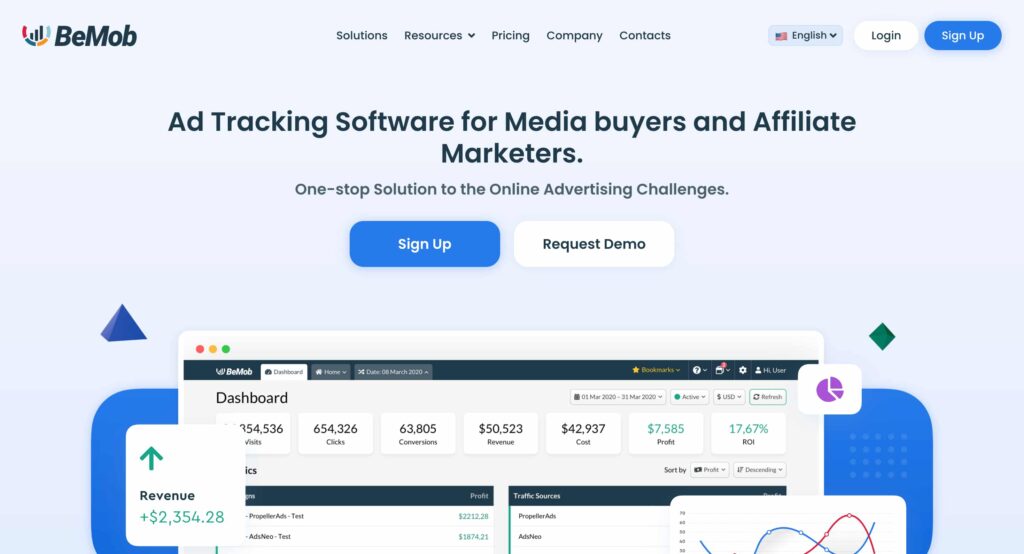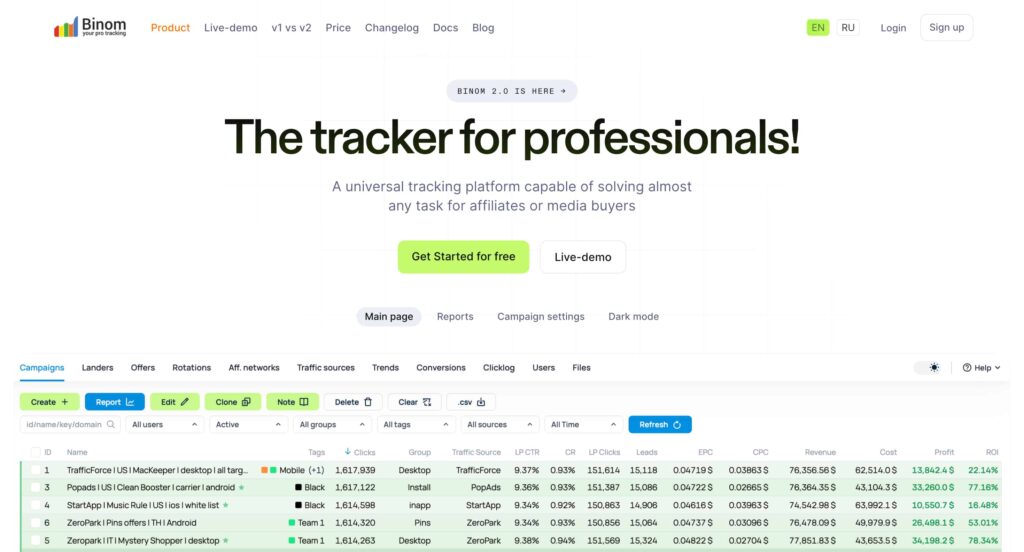Blog

Affiliate marketing KPI is crucial for measuring success and performance. By tracking these indicators, both advertisers and marketers can gain valuable insights into the effectiveness of their campaigns, identify top-performing bundles, and optimize strategies.
In this article, we will delve into the key performance indicators in affiliate marketing that you should track to assess the performance of their affiliate campaigns.
Key Performance Indicator (KPI) is a metric to evaluate the performance of an affiliate campaign. They are ROI, conversion rates, clicks, engagement, and so on. These metrics help affiliate marketers as well as advertisers track and measure the success of their campaigns and optimize their strategies for better results.
Here’s a take on the importance of tracking marketing performance metrics:
In essence, tracking KPIs in affiliate marketing is not just about numbers. It’s about harnessing the power of data to steer your campaigns towards success, cultivate fruitful partnerships, and make informed decisions that propel your affiliate marketing initiatives to unparalleled levels of achievement.
Let’s have a look at the most important affiliate marketing KPIs you need to focus on when running campaigns.
The goal of many advertisers, especially those in the eCommerce vertical, is sales. Analyzing this metric is essential because it can help you understand which marketing strategies are driving sales and which ones are driving users away.
Each sale is one successfully completed transaction. The number of transactions made by each customer helps to evaluate the effectiveness of the advertising campaign. Moreover, affiliates that generate thousands of clicks, but dozens of them are purchases, may be involved in fraudulent activities.
For both affiliates and advertisers, clicks are important. Their number depends on the number of users that the affiliate was able to attract to the merchant’s website or landing page.
Clicks show how many times users clicked on the ad and how wide distribution your product gets. Their main purpose is to increase recognition. Thus, clicks are an indicator of reaching a wide audience.
At the same time, it is not enough for marketers to only click. To better evaluate the effectiveness of a campaign, additional metrics such as registrations or purchases need to be analyzed. From here, we can move on to the next indicator like conversion rates.
Clicks without conversions are of little value to advertisers. Conversion rate measures the percentage of clicks converted into buyers. And this is one of the most important metrics in advertising.
A high conversion rate means that your affiliate is showing ads to an audience interested in the offer. If the number of conversions is much lower than clicks, then the target users are not chosen correctly.
Another reason for a low conversion rate could be bad creative or a technical error. This can be corrected with a full-fledged analysis of the advertising campaign.
4. Сlick-Through Rate (CTR)
Click-Through Rate (CTR) shows the percentage of users clicking an affiliate link among those who see the webpage or advertisement showcasing the link. In essence, CTR serves as a barometer of an advertising campaign’s success in captivating the audience’s interest and motivating them to take action.

Within the affiliate marketing, an elevated CTR typically indicates a stronger match between your content and your audience’s preferences. However, it’s crucial to bear in mind that while CTR provides valuable insights, it represents just a single aspect of the equation. Achieving genuine success in affiliate marketing necessitates transforming these clicks into tangible actions such as registrations, sales, or other intended results.
When launching an advertisement for their product or service, an advertiser is usually investing in it. Hence the next metric to track: RWhatever your business is, no matter how big or small, your marketing campaign should focus on return on investment. Expressed as a percentage, a simple way to calculate ROI is to divide the gross profit generated by the investment in your affiliate program and multiply by one hundred.
In terms of KPIs in affiliate marketing, this figure is defined as total revenue divided by your costs to create an affiliate program (commission, affiliate network software, etc.). If the resulting figure is $1, that’s effectively zero revenue – you spend a dollar and get a dollar back.
Customer lifetime value is a way to figure out how much money the average customer brings to a company over time. It’s like looking at how valuable each customer is in the long run.
When we talk about this, we’re interested in customers who keep coming back and spending a lot of money, not just those who make a one-time purchase and then shop elsewhere. By measuring customer lifetime value, we can see how well affiliate marketing is bringing in these valuable, loyal customers.
By setting goals based on this metric, you can improve your affiliate marketing strategies. You can see which affiliate activities are good at attracting valuable customers and which affiliates are doing a great job. This information can also help you set up your affiliate program better by figuring out how to reward the best activities and affiliates.
Average Order Value (AOV) is about how much money customers spend on average in one transaction. It’s not just about how many sales are made, but the value of each sale.
A high AOV shows that affiliates are good at convincing customers to buy more than they planned to, by upselling and cross-selling. This means more money is earned from each customer.
For businesses, AOV is important in managing affiliate programs because it helps measure how well the affiliate marketing campaigns are performing. A higher AOV means more revenue from each sale.
For instance, if a business makes $100,000 in sales with an AOV of $100, that’s 1,000 orders. If they increase the AOV to $150, they can earn an extra $50,000 without making more sales.
Tracking AOV helps identify which affiliates bring in the most money per sale. This way, businesses can focus on those affiliates to maximize their earnings.
One of the crucial KPIs for affiliates is EPC. The calculation of Earnings Per Click by dividing Commission by Clicks is crucial in assessing new advertisers. Additionally, affiliates frequently examine this key performance indicator for each advertiser to guarantee fair compensation for the traffic they generate.
An affiliate’s job isn’t just to bring in new customers. You need to make sure that old customers also come back again for a purchase, installation or deposit. If those customers never come back, however, they are of little value to the business.
Therefore, in affiliate marketing, you need to be able to determine the ratio between new and returning users. You can determine a percentage range that is “normal” for you and within which your affiliate partner should operate.
Affiliate Engagement Rate measures how involved and active affiliates are in promoting your products or services. Engaged affiliates are more likely to be creative, persistent, and successful in driving sales.
Measuring affiliate engagement can be tricky. You can look at how often affiliates interact with your marketing materials, take part in training, join your campaigns, and more. Essentially, it involves counting the various ways affiliates engage with your program.
On forums, affiliates usually share their case studies. We encourage you to check out the best affiliate marketing forums to sign up for in 2024 to learn more about campaign performance metrics.
There are other affiliate marketing metrics for networks and programs owners.
To make your affiliate marketing program successful, it’s crucial to compare and assess your performance against industry standards. By analyzing industry data, you can understand where you stand among competitors and discover the most suitable niche for your affiliate marketing efforts.
Let’s delve into key affiliate metrics that help you pinpoint top-performing affiliates and strategize for program improvement:
Identify affiliates driving the most sales. Tracking affiliate sales helps in setting targets and rewards for high achievers. Keep a keen eye on top partners as they are pivotal for your success. Monitoring the number of sales per affiliate also aids in spotting new affiliates with potential for growth.
This metric often goes unnoticed but offers valuable insights. Monitoring the growth of affiliate partners is crucial. If your top affiliates show stagnant numbers year after year, it’s vital to investigate the reasons. Compare growth rates to identify affiliates showing promising improvement. Prioritize nurturing affiliates showing steady growth over time.
Assessing audience engagement helps evaluate the quality of traffic. Successful affiliates have dedicated and engaged audiences who interact actively with their content. Audience engagement is key as people tend to trust recommendations from reliable sources. Metrics like visit duration and pages viewed reflect engagement levels.
Tools like Similarweb provide an engagement score per affiliate, simplifying the analysis process. Affiliates with high engagement scores typically drive valuable traffic. If engagement is lacking, it might indicate a mismatch between audiences or affiliates diverting traffic to competitors. In such cases, investigate and adapt strategies to stay competitive.
Here’s a simple guide on how to track affiliate marketing success:
By following these steps and consistently tracking and analyzing affiliate marketing metrics and KPIs, you can optimize your program for success and drive sustainable growth.

BeMob allows you to quickly test landing pages, track traffic, and optimize ROI. You can customize campaign settings and tracking preferences. All campaign data is securely stored in the cloud.
Key features of BeMob include tracking conversion rates, accounting for traffic loss percentages from various sources, and automatically redirecting traffic when conversions for an offer reach a limit.
What is more, BeMob offers a free trial until you reach 100,000 events per month. After this limit, there is a charge of $0.06 per 1000 events. The event limits for different plans are: up to 1,000,000 events, up to 10,000,000 events, and up to 30,000,000 events. If you exceed the event limit on your plan, additional events will cost $0.06 per 1000 events.

Keitaro is a versatile and efficient server-based tracker.
What does it provide?
You can fine-tune access permissions, granting clients access to reports and colleagues access to campaigns. The tracker is installed on a server.
Keitaro conducts landing page tests and supports various combinations and targeted landing pages.
It safeguards landing pages from bots with a database of over 500,000 IP addresses updated monthly. Additionally, Keitaro enables cloaking setup and facilitates passing moderation in advertising networks.

Binom stands out as a high-speed tracker designed to handle heavy traffic loads. Its processing speed is exceptional, with a click being processed in just 7 milliseconds.
With its user-friendly interface and incredibly fast reporting capabilities, Binom ranks among the top tracking solutions available:
While Binom’s initial price may be slightly higher at $99 compared to competitors, it offers unlimited volume capacity and allows entire teams to collaborate within a single account.
Careful tracking of affiliate marketing analytics is fundamental to success. These KPIs serve as signposts that guide partners, showing them the path to understanding performance, optimizing strategies and creating profitable partnerships. By consistently measuring metrics such as number of clicks, conversion rates, sales per affiliate and engagement, you can gain valuable insights and make informed decisions.
Affiliate marketing KPI is crucial for measuring success and performance. By tracking these indicators, both advertisers and marketers can gain valuable insights into the effectiveness of their campaigns, identify top-performing bundles, and optimize strategies.
In this article, we will delve into the key performance indicators in affiliate marketing that you should track to assess the performance of their affiliate campaigns.
Key Performance Indicator (KPI) is a metric to evaluate the performance of an affiliate campaign. They are ROI, conversion rates, clicks, engagement, and so on. These metrics help affiliate marketers as well as advertisers track and measure the success of their campaigns and optimize their strategies for better results.
Here’s a take on the importance of tracking marketing performance metrics:
In essence, tracking KPIs in affiliate marketing is not just about numbers. It’s about harnessing the power of data to steer your campaigns towards success, cultivate fruitful partnerships, and make informed decisions that propel your affiliate marketing initiatives to unparalleled levels of achievement.
Let’s have a look at the most important affiliate marketing KPIs you need to focus on when running campaigns.
The goal of many advertisers, especially those in the eCommerce vertical, is sales. Analyzing this metric is essential because it can help you understand which marketing strategies are driving sales and which ones are driving users away.
Each sale is one successfully completed transaction. The number of transactions made by each customer helps to evaluate the effectiveness of the advertising campaign. Moreover, affiliates that generate thousands of clicks, but dozens of them are purchases, may be involved in fraudulent activities.
For both affiliates and advertisers, clicks are important. Their number depends on the number of users that the affiliate was able to attract to the merchant’s website or landing page.
Clicks show how many times users clicked on the ad and how wide distribution your product gets. Their main purpose is to increase recognition. Thus, clicks are an indicator of reaching a wide audience.
At the same time, it is not enough for marketers to only click. To better evaluate the effectiveness of a campaign, additional metrics such as registrations or purchases need to be analyzed. From here, we can move on to the next indicator like conversion rates.
Clicks without conversions are of little value to advertisers. Conversion rate measures the percentage of clicks converted into buyers. And this is one of the most important metrics in advertising.
A high conversion rate means that your affiliate is showing ads to an audience interested in the offer. If the number of conversions is much lower than clicks, then the target users are not chosen correctly.
Another reason for a low conversion rate could be bad creative or a technical error. This can be corrected with a full-fledged analysis of the advertising campaign.
4. Сlick-Through Rate (CTR)
Click-Through Rate (CTR) shows the percentage of users clicking an affiliate link among those who see the webpage or advertisement showcasing the link. In essence, CTR serves as a barometer of an advertising campaign’s success in captivating the audience’s interest and motivating them to take action.

Within the affiliate marketing, an elevated CTR typically indicates a stronger match between your content and your audience’s preferences. However, it’s crucial to bear in mind that while CTR provides valuable insights, it represents just a single aspect of the equation. Achieving genuine success in affiliate marketing necessitates transforming these clicks into tangible actions such as registrations, sales, or other intended results.
When launching an advertisement for their product or service, an advertiser is usually investing in it. Hence the next metric to track: RWhatever your business is, no matter how big or small, your marketing campaign should focus on return on investment. Expressed as a percentage, a simple way to calculate ROI is to divide the gross profit generated by the investment in your affiliate program and multiply by one hundred.
In terms of KPIs in affiliate marketing, this figure is defined as total revenue divided by your costs to create an affiliate program (commission, affiliate network software, etc.). If the resulting figure is $1, that’s effectively zero revenue – you spend a dollar and get a dollar back.
Customer lifetime value is a way to figure out how much money the average customer brings to a company over time. It’s like looking at how valuable each customer is in the long run.
When we talk about this, we’re interested in customers who keep coming back and spending a lot of money, not just those who make a one-time purchase and then shop elsewhere. By measuring customer lifetime value, we can see how well affiliate marketing is bringing in these valuable, loyal customers.
By setting goals based on this metric, you can improve your affiliate marketing strategies. You can see which affiliate activities are good at attracting valuable customers and which affiliates are doing a great job. This information can also help you set up your affiliate program better by figuring out how to reward the best activities and affiliates.
Average Order Value (AOV) is about how much money customers spend on average in one transaction. It’s not just about how many sales are made, but the value of each sale.
A high AOV shows that affiliates are good at convincing customers to buy more than they planned to, by upselling and cross-selling. This means more money is earned from each customer.
For businesses, AOV is important in managing affiliate programs because it helps measure how well the affiliate marketing campaigns are performing. A higher AOV means more revenue from each sale.
For instance, if a business makes $100,000 in sales with an AOV of $100, that’s 1,000 orders. If they increase the AOV to $150, they can earn an extra $50,000 without making more sales.
Tracking AOV helps identify which affiliates bring in the most money per sale. This way, businesses can focus on those affiliates to maximize their earnings.
One of the crucial KPIs for affiliates is EPC. The calculation of Earnings Per Click by dividing Commission by Clicks is crucial in assessing new advertisers. Additionally, affiliates frequently examine this key performance indicator for each advertiser to guarantee fair compensation for the traffic they generate.
An affiliate’s job isn’t just to bring in new customers. You need to make sure that old customers also come back again for a purchase, installation or deposit. If those customers never come back, however, they are of little value to the business.
Therefore, in affiliate marketing, you need to be able to determine the ratio between new and returning users. You can determine a percentage range that is “normal” for you and within which your affiliate partner should operate.
Affiliate Engagement Rate measures how involved and active affiliates are in promoting your products or services. Engaged affiliates are more likely to be creative, persistent, and successful in driving sales.
Measuring affiliate engagement can be tricky. You can look at how often affiliates interact with your marketing materials, take part in training, join your campaigns, and more. Essentially, it involves counting the various ways affiliates engage with your program.
On forums, affiliates usually share their case studies. We encourage you to check out the best affiliate marketing forums to sign up for in 2024 to learn more about campaign performance metrics.
There are other affiliate marketing metrics for networks and programs owners.
To make your affiliate marketing program successful, it’s crucial to compare and assess your performance against industry standards. By analyzing industry data, you can understand where you stand among competitors and discover the most suitable niche for your affiliate marketing efforts.
Let’s delve into key affiliate metrics that help you pinpoint top-performing affiliates and strategize for program improvement:
Identify affiliates driving the most sales. Tracking affiliate sales helps in setting targets and rewards for high achievers. Keep a keen eye on top partners as they are pivotal for your success. Monitoring the number of sales per affiliate also aids in spotting new affiliates with potential for growth.
This metric often goes unnoticed but offers valuable insights. Monitoring the growth of affiliate partners is crucial. If your top affiliates show stagnant numbers year after year, it’s vital to investigate the reasons. Compare growth rates to identify affiliates showing promising improvement. Prioritize nurturing affiliates showing steady growth over time.
Assessing audience engagement helps evaluate the quality of traffic. Successful affiliates have dedicated and engaged audiences who interact actively with their content. Audience engagement is key as people tend to trust recommendations from reliable sources. Metrics like visit duration and pages viewed reflect engagement levels.
Tools like Similarweb provide an engagement score per affiliate, simplifying the analysis process. Affiliates with high engagement scores typically drive valuable traffic. If engagement is lacking, it might indicate a mismatch between audiences or affiliates diverting traffic to competitors. In such cases, investigate and adapt strategies to stay competitive.
Here’s a simple guide on how to track affiliate marketing success:
By following these steps and consistently tracking and analyzing affiliate marketing metrics and KPIs, you can optimize your program for success and drive sustainable growth.

BeMob allows you to quickly test landing pages, track traffic, and optimize ROI. You can customize campaign settings and tracking preferences. All campaign data is securely stored in the cloud.
Key features of BeMob include tracking conversion rates, accounting for traffic loss percentages from various sources, and automatically redirecting traffic when conversions for an offer reach a limit.
What is more, BeMob offers a free trial until you reach 100,000 events per month. After this limit, there is a charge of $0.06 per 1000 events. The event limits for different plans are: up to 1,000,000 events, up to 10,000,000 events, and up to 30,000,000 events. If you exceed the event limit on your plan, additional events will cost $0.06 per 1000 events.

Keitaro is a versatile and efficient server-based tracker.
What does it provide?
You can fine-tune access permissions, granting clients access to reports and colleagues access to campaigns. The tracker is installed on a server.
Keitaro conducts landing page tests and supports various combinations and targeted landing pages.
It safeguards landing pages from bots with a database of over 500,000 IP addresses updated monthly. Additionally, Keitaro enables cloaking setup and facilitates passing moderation in advertising networks.

Binom stands out as a high-speed tracker designed to handle heavy traffic loads. Its processing speed is exceptional, with a click being processed in just 7 milliseconds.
With its user-friendly interface and incredibly fast reporting capabilities, Binom ranks among the top tracking solutions available:
While Binom’s initial price may be slightly higher at $99 compared to competitors, it offers unlimited volume capacity and allows entire teams to collaborate within a single account.
Careful tracking of affiliate marketing analytics is fundamental to success. These KPIs serve as signposts that guide partners, showing them the path to understanding performance, optimizing strategies and creating profitable partnerships. By consistently measuring metrics such as number of clicks, conversion rates, sales per affiliate and engagement, you can gain valuable insights and make informed decisions.

Blog

Blog